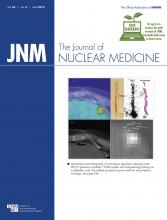TO THE EDITOR: Chitneni et al. compared 18F-labeled and unlabeled 2-(2-nitro-1H-imidazol-1-yl)-N-(2,2,3,3,3-pentafluoropropyl)-acetamide (EF5) uptake in 1 rat and 2 murine xenograft tumor models (1). For the H460 model (rat), concern was expressed over retention of label, determined by autoradiography, in areas not positive for EF5 adducts as determined by immunohistochemistry (1). There are 3 sources of signal for the autoradiographs (and PET images): parent drug, metabolized unbound drug, and metabolized bound drug. About 25% of bioreductively metabolized EF5 is bound to macromolecules (2). Thus, PET image or autoradiograph contrast is affected by pharmacokinetic loss of parent and metabolized unbound drug. The half-life of EF is 150 min in rats but only 50 min in mice (3). Thus, at the 3-h time point assessed, 5 times more free and metabolized unbound drug is expected in the rat H460 than in murine tumors. To optimally compare immunohistochemistry with autoradiography, one should fix both sections; fixation removes the free drug and metabolized unbound products. For typical hypoxic tumors in rats, about 75% of the total radioactivity disappears for the fixed sections. What remains is a near-perfect representation of the immunohistochemically determined bound EF5 (4). In humans, the half-life of EF5 and similar drugs is longer than that in rats (much greater than the 18F isotope half-life), resulting in a fundamental decrease in PET contrast compared with mice. If the observed effect was caused by oxygen-independent EF5 metabolism, as hinted by the authors, this would be the first example of such metabolism found for EF5.
For the same H460 model, higher contrast at a 10-fold reduced drug concentration was explained by a possible decrease in drug half-life (1). In humans there is only a 2-fold decrease in the half-life of EF5 for a concentration decrease of about 10,000. An alternative explanation lies in the kinetics of drug binding as a function of drug and oxygen concentration. For many 2-nitroimidazoles, binding will change from first order to approximately half order in drug concentration at severely low oxygen concentrations (4,5). The result is an increase in relative binding to severely hypoxic cells as drug concentration decreases. Thus, if the H460 tumors contained regions of severe hypoxia, they would show the concentration effect observed.
In the Chitneni paper, the authors suggest that uptake of 2-nitroimidazoles such as EF5 selects for tissues that have a partial pressure of oxygen less than 10 mm Hg. In our experience, EF5 binding will change continuously with tissue partial pressure of O2 and is severalfold higher at 10 mm Hg than at more physiologic oxygen levels (6). This finding has relevance to additional comparisons between immunohistochemistry and PET or autoradiography for the tumors described: a relatively large volume of moderate hypoxia will look the same on a PET image as distributed smaller volumes of more severe hypoxia. This may be true for all imaging agents but has been studied in detail only for EF5. The immunohistochemistry image of the PC3 tumor (Fig. 2 of Chitneni et al.) is illustrative. In this tumor, contiguous regions of “hypoxia” extend over many square millimeters of tissue. We have described this observation as macroscopic regional hypoxia (7). Although a small area of decreased binding is seen around a large artery pair or vein pair, there are undoubtedly many hundreds of individual vessels in the total tumor cross section shown. This important observation appears to be the first example published of macroscopic regional hypoxia in an epithelial murine tumor. In contrast, the HCT116 tumor (Fig. 3 of Chitneni et al.) shows a highly repetitive pattern of high and low EF5 binding, with the low values undoubtedly centered on oxygen-carrying vessels, consistent with classic diffusion-limited hypoxia (4). Clearly, “hypoxia” is different in these 2 tumor types.
In summary, we suggest some additional interpretations of the very nice data presented by the Duke group.
Footnotes
Published online Mar. 5, 2015.
- © 2015 by the Society of Nuclear Medicine and Molecular Imaging, Inc.







